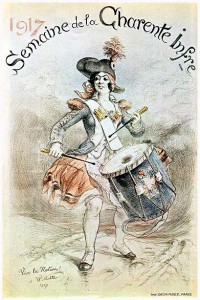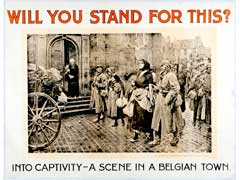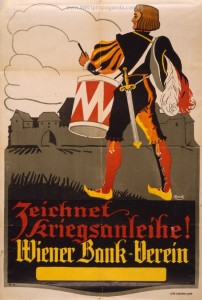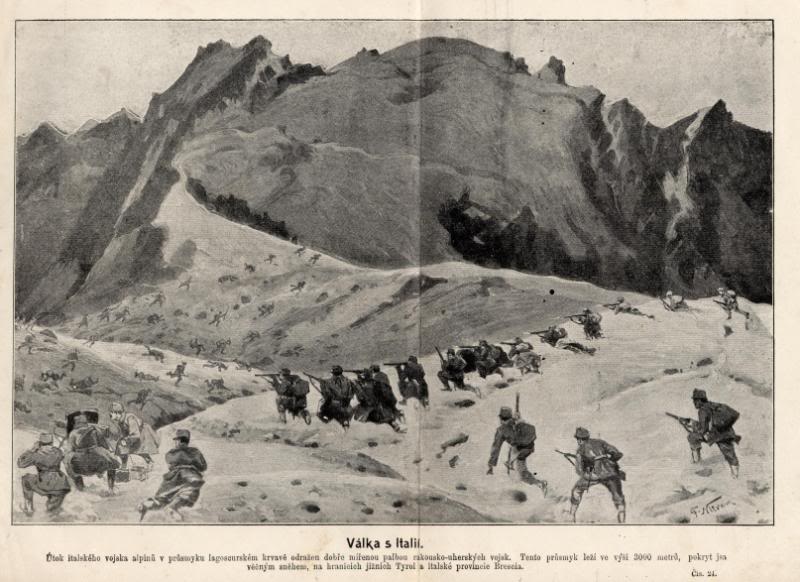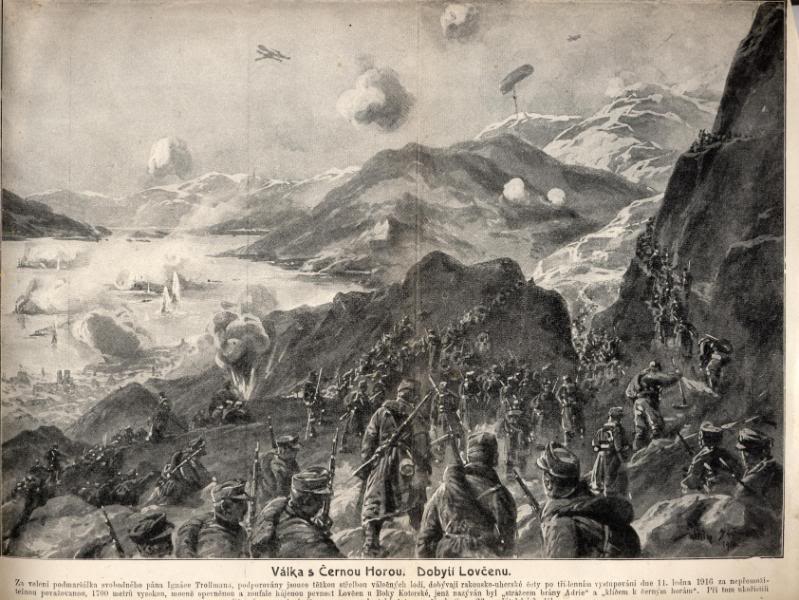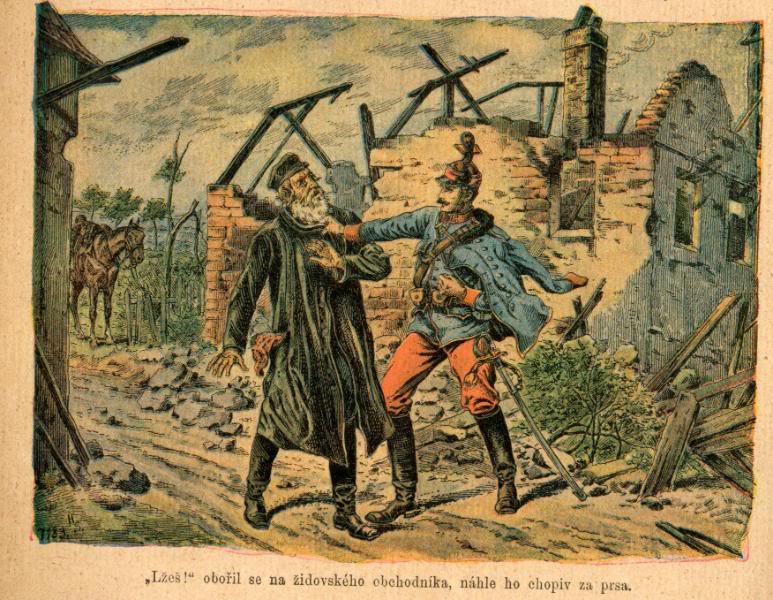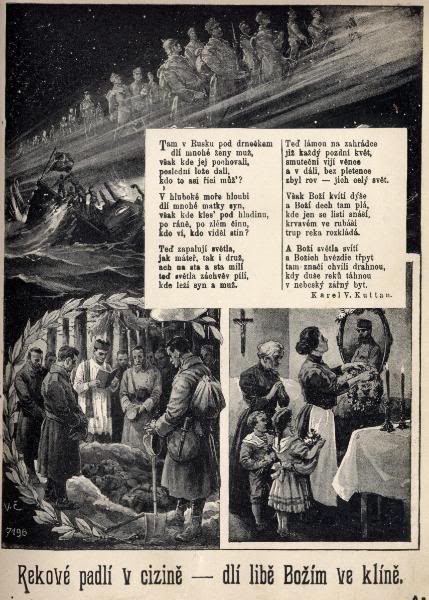Edited by: Alec Davis
Introduction
The First World War was set in motion with the assassination of one man, the Archduke Franz Ferdinand, following a period of political tension within Europe. Many European countries did not expect to be committed to a highly truculent war from 1914-1918. As the war raged on towards its record setting 5,380,000 casualties, morale on the home front in both the Central Powers and the Allies sank. Great Britain, France, Russia, Germany, and Austria-Hungary turned to various forms of propaganda as a tool to popularize support for involvement in World War I. Propaganda played a significant factor in keeping armies from withering away due to lack of recruits and support. In turn, national propaganda moved empires and spurred on nations to take a lead role in World War I. The time frame of such propaganda promoting World War I involvement is specifically limited to the war era of 1914-1918.
Three main sections compose this research guide; General Overview of World War I, Propaganda in the Allied Forces, and Propaganda in the Central Powers. The first section contains general overviews of World War I to establish a general knowledge and historical context. I have included sources that focus on military strategy for basic understanding of the physical war along with home front sources that provide a better understanding of war era dynamics at home. Within the two propaganda specific sections I focused on five countries total in order to compile cohesive and productive sources. Propaganda in the Allied Forces contains sources from each country; France, Great Britain, and Russia in various forms for an over all view of what citizens would encounter on a daily basis. Propaganda in the Central Powers contains sources from each country as well; Germany and Austria-Hungary to pursue a less common view point studied in World War I.
World War I studies limited to the militarily victorious Allies’ point of view are dominant in the United States today. However, without taking into account both points of view biased studies form. This research guide is purposed to serve as a starting point for a well rounded inquiry into the propaganda used to propel World War I.

Allied forces propaganda poster. Publicized in Great Britain to boost home front morale and strengthen alliances.
General Overview of World War I
-
Researching World War I: a Handbook
This research guide analyzes all aspects of World War I, from training new recruits to home front rationing, in great detail. Each chapter covers one country socially, economically and politically using a plethora of scholarly facts. Higham and Showalter repeatedly compare and contrast World War I with other wars around the globe, such as the Russo-Japanese War, to analyze military strategy and domestic morale. In addition to presenting factual overviews put into historical context, Higham and Showalter provide the reader with an abundance of supplemental sources that offer the opportunity to further research a specific topic in depth.
Higham, Robin, and Dennis E. Showalter, eds. Researching World War I: A Handbook. Westport: Greenwood Press, 2003.
-
A History of the Great War
Lt. Col. John Buchan’s four volume series explores the history of World War I, The Great War, from a militaristic point of view. Buchan possessed access to classified information as the Director of the Department of Information for the British government while developing these volumes. Volume two contains maps of battles true to the World War I era that add to this source’s value. Although Buchan put together A History of the Great War based on the Great Britain’s view point he offers his information without the dilution of time.
Buchan, John. A History of the Great War in Four Volumes. Vol. 2, A History of the Great War. Boston: Houghton Mifflin Company, 1922.
-
World War I- Britannica Academic Edition
The Britannica Online Encyclopedia offers a bias-free scholarly source for information on World War I. This site also contains links to specific subjects within World War I including maps of battles, informational videos on political boarders, posters used as propaganda, and interactive activities to further explore the subject.
-
The First World War Documentary
Produced as a free documentary, this source examines the political unrest in the origins of World War I. It analyzes pre-war political tension around the Austrian Empire and Serbia as necessary, and continues through to the formation of the Allies and the Central Powers military alliances. Although this video discusses theories, it remains neutral and unbiased.
-
Personal Perspectives: World War I
Personal Perspectives offers a general insight of World War I by threading together groups of experiences. This resource covers a vast range of views pulling from British Indian soldiers, allied medical personnel, and women on the home front. Timothy C. Dowling successfully puts individual views, tinted with bias, into perspective. He confronts the hardest aspect to comprehend about a war, the effect it had in an individual’s personal life.
Dowling, Timothy C. Personal Perspectives: World War I. Santa Barbara: ABC-CLIO, 2005.
-
Daily Life During World War I
This source evaluates World War I through personal experiences in a collective format. Heyman exploits the views of military members as well as families left behind to face supply demands, covering both spheres of World War I. Due to the elephantine scope of the war this book narrows it’s scope to the western front. Despite only addressing the popular western front, Heyman does not limit himself to trench warfare and includes the experiences of navy personnel involved in submarine warfare and air force pilots in combat in the sky. Daily Life During World War I presents a thorough chronology of events and an abundance of further readings on various subjects.
Heyman, Neil F. Daily Life During World War I. Westport:Greenwood Press, 2002.
-
The Last Great War: British Society and the First World War
Adrian Gregory’s The Last Great War: British Society and the First World War is an investigation of the course of the war for Great Britain’s civilian population. This source does not cover all aspects of the war. In fact, it backs away from most of the political concerns of the era. Rather than a purely factual textbook, it is both a general synthesis examining some of the cultural attitudes and experiences of civilians during the war and a captivating analytical study of some of the war’s more controversial social, religious, and economic debates. Although Gregory apologizes for not detailing the concerns of uniformed men directly and neglecting “military history, strictly defined,” The Last Great War effectively analyzes World War I on the home front.
Gregory, Adrian. The Last Great War: British Society and the First World War. New York: Cambridge University Press, 2008.
Propaganda in the Allied forces- France, Great Britain and Russia
-
More Songs by the Fighting Men
This source, published in 1917, is a collection of poems produced from World War I soldiers; Sapper De Banzie, Sub-Lieut. Bewsher, Sergt. Brooks, Lieut. Carstairs, Corpl. Challenger, Pte. Chilman, Lieut. Choyce, second Lieut. Clements, M.C. second Lieut. Cook, second Lieut. Cooper, Sergt. Coulson, Pte. Cox, and Capt. Crombie among others. The British government publicized poetry from military personnel as a form of support for soldiers throughout the war. This collection of poetry ranges in subject from love interests at home to serene scenes of nature juxtaposing barren battle fields.
MacDonald, Erskine, ed. More Songs by the Fighting Men. London: Erskine MacDonald Ltd., 1917.
-
Week of the Charente Infre
Semaine de la Charlenete Infre is a paragon for French propaganda techniques. The musician in the center wears a military uniform in support of soldiers battling in World War I. French propaganda often incorporated references to the Revolutionary spirit of 1789 through dress or dramatic settings for French nationalism.
-
It’s a Long Way to Tipperary
It’s a Long Way to Tipperary, written by Jack Judge and co-credited to Henry James Williams, became popular among soldiers. Tipperary refers to Judge’s hometown Tipperary Ireland, simply representing home in this song. After the Connaught Ranger regiment sang it while marching through Boulonge the song became popular among citizens of Great Britain. It’s a Long Way to Tipperary, written about a soldier returning home from war to his lover Molly, kept a hopeful morale up at home.
-
Generic Russian Propaganda Poster
This pre-Russian Revolution image portrays the Russian Red Knight’s struggles against the dark forces of Europe, the Central powers. A simple layman with a metallurgy hammer represents the majority of Russian citizens during World War I. Suffering 1,800,000 casualties, the most casualties from a single country, the declining Russian government turned to propagandized images during World War I.
This poster printed in Great Britain for Queensland in World War I suggests perhaps what might be expected in Australia if the German occupation of Belgium expanded and reached to the Pacific. Images of destruction and chaos caused by the Central Powers were publicized to increase enlistment rates. Such images were intended to inspire Australians to enlist in the Australian Imperial Force.
Propaganda in the Central Powers- Germany, Austria-Hungary, and the Ottoman Empire
-
German Post Card “We Teach You To Run!”
We Teach You To Run! produced by the German PYSOP, an organization that claimed propaganda leaflets immoral and illegal, intended to boost German morale by depicting a successful war in which their enemies ran away. Although the Austria-Hungary Empire began World War one Germany became the more powerful militant force as seen in this poster.
-
Allied Propaganda and the Collapse of the German Empire in 1918
Bruntz examines propaganda within the allies as wells as Germany thoroughly and provides relations from political propaganda to social changes in mood. He suggests that early in the war Germany conducted a campaign of patriotic propaganda at home to keep up the morale of the German people and the troops. The Kriegspresseamt,War Press office, did this work and also the task of issuing war news to the German press. There was no concentrated effort to produce propaganda in the early years of the war and Germany fell far behind the Allies.
Bruntz, George. Allied Propaganda and the Collapse of the German Empire in 1918. Palo Alto: Stanford University Press, 1938.
-
War Bond Drive Posters
These posters support the sale of war bonds to prop up the cause of fighting the Allies among citizens whose spirits are worn our. The Austria-Hungary government promoted an abundance of war bond drives through propaganda not only to fund the military, but also to provide citizens with the sense of individual importance. War bond drive posters were Austria-Hungary’s second most common propaganda source, right behind censored newspaper articles.
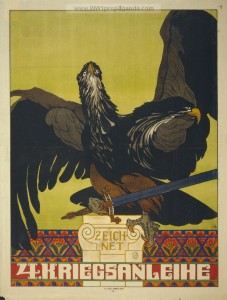
The fourth war bond drive propaganda poster with the Austro-Hungarian double headed eagle as a symbol of strength clasping a sword in it's talon.

The fifth Austria-Hungary war bond drive held in 1916. Soldiers are displayed on this poster to draw guilt and support from viewers.

The eighth war bond drive held by Austria-Hungary. A plane dropping banners advertising the war bond drive is depicted to advertise effectively.
The Austria-Hungary Empire government produced most of its propaganda through censored newspaper reports of the “truth” from the front lines. This 1917 edition of an annual censored newspaper contains images and descriptions that tell citizens what they desire to hear from the war. The first, second, and third newspaper clippings show valiant battles against the enemy forces to imply a quick victory in World War I. The fourth clipping depicts an Astro-Hungarian hero dealing with a Jewish scoundrel to assert Austria-Hungary’s authoritative power. The fifth clipping describes a heart warming story about Archduke Franz Karl to unify citizens under him.
-
Prayer for the Fallen
Austro-Hungarian propaganda was not limited to military or political focus, this clipping extends propaganda to include religious tactics. Influence on the citizenry increased with expansion of propaganda to include religion because once the government related to each individual in multiple ways they would gain more influence.

